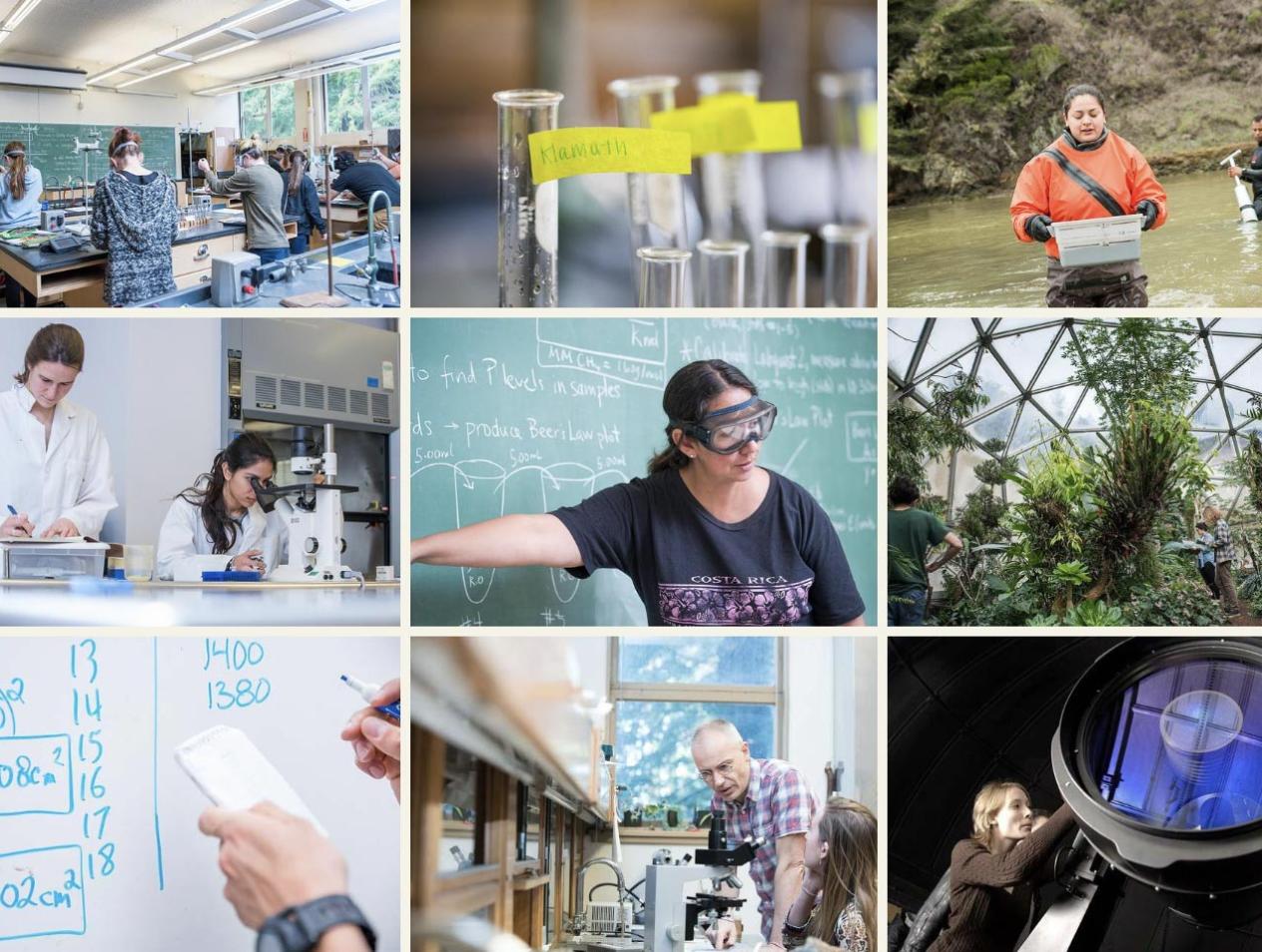Breadcrumb
Achievements
Find out what our students, faculty, and staff are being recognized for.
Emma Held, Darren Ward
Fisheries Biology
Emma Held was awarded a research fellowship from California Sea Grant to support her work on the life history of threatened Chinook salmon in the Mattole River. Emma's work will provide information to support ongoing conservation efforts by collaborators at the Mattole Salmon Group.
Lucy Kerhoulas, Rosemary Sherriff, Erik Jules, and Michael Kauffmann
Forestry, Fire & Rangeland Management
Lucy Kerhoulas, Rosemary Sherriff, Erik Jules, and Michael Kauffmann were awarded a $1.1 million grant to complete extensive vegetation mapping in the Klamath Mountains Ecoregion. Project vegetation surveys will be compared to vegetation surveys from the 1960s, 1980s, and 2010s to evaluate the influences of fire and climate change on high elevation plant communities.
The work will support three graduate students and numerous undergraduate students and will contribute substantially to the Cal Poly Humboldt Vascular Plant Herbarium; Robin Bencie and the California Native Plant Society are also project collaborators. Funding comes from the CA Department of Fish & Wildlife.
Jeffrey Abell, Tamara Barriquand, Christine Cass, Malcolm Edwards-Silva, Kenneth Mathe, Marcos Moreno, Carla Villanueva, Ethan Wadsworth
Oceanography
Oceanography faculty Jeffrey Abell, Tamara Barriquand, and Christine Cass presented their research at the international Ocean Sciences Meeting (New Orleans, LA) in February. This ~6,000 person conference brings together marine scientists from across disciplines. Undergraduate students Malcolm Edwards-Silva, Marcos Moreno, Carla Villanueva, Ethan Wadsworth, and Kenneth Mathe (Fall '23) also attended to present a poster on their capstone research project.
Pedro Peloso, Brandice Guerra
Biological Sciences
Professors Pedro Peloso (Biological Sciences) and Brandice Guerra received a grant from the Maxwell/Hanrahan Foundation (www.maxwell-hanrahan.org) to support an illustration internship at Cal Poly Humboldt. An international student will visit our community this spring to work in a project that aims to raise awareness about amphibian extinctions globally. You can read more about the internship here: https://now.humboldt.edu/news/new-scientific-illustration-internship-gi…
Kjirsten Wayman, Maralyn Renner, Alexander Wright, Aaron Floden, Jayne Lampley, Susan Farmer, Edward Schilling
Chemistry
Kjirsten Wayman (Chemistry Department), Maralyn Renner (M.S. Biology, 1980), Alexander Wright (Washington State U.), Aaron Floden (Missouri Botanical Garden), Jayne Lampley (U. Alabama), Susan Farmer, Edward Schilling (U. Tennessee, Knoxville) published a peer-reviewed article titled “New insights into systematics of the Trillium ovatum complex” in Madroño, a journal focusing on research of the Western American flora. The article highlights Trillium oettingeri, an endemic plant to the Klamath Mountains and Cascade Range, and can be accessed at the following link: https://doi.org/10.3120/0024-9637-70.3.158
Alana Chin
Biological Sciences
Dr. Alana Chin received a grant to support research looking into factors impacting redwood tree fog-uptake. Redwood trees absorb water from fog, making it a key provider of water in the summer months. However, as the climate changes, so have fog characteristics, increasing the need to understand how redwoods are acclimating to changes in fog. The project will assess and monitor fog absorption capacity in redwoods, and is a critical next step in our ability to predict the impacts of climate change on redwoods and select nursery stock for restoration.
Funding comes from the Save the Redwoods League.
Daniel Barton
Wildlife
Dan Barton (Associate Professor and Department Chair, Wildlife) was elected chair of the Pacific Seabird Group, a role in which he will serve for the next three years. Pacific Seabird Group is a society of professional seabird researchers and managers that was formed in 1972 out of a need for increased communication among academic and government seabird researchers, and currently has over 500 members from around the world. The society also publishes the journal Pacific Seabirds.
Kerry Byrne and Catalina Cuellar-Gempeler
Environmental Science & Management
Drs. Kerry Byrne and Catalina Cuellar-Gempeler received a grant to support a study on Applegate’s milkvetch, a federally endangered plant species found only in the lower Klamath Basin of southern Oregon. The project will investigate alternative management practices that may better promote Applegate's milkvetch recovery, and ultimately provide managers with a roadmap for optimal management of this species. Collaborators will include Oregon Parks and Recreation Department, US Fish and Wildlife Service, ODA, and the City of Klamath Falls, OR.
Range Plant Identification team
Forestry, Fire & Rangeland Management
Cal Poly Humboldt’s Range Plant Identification team placed 5th in a contest during the Society for Range Management Meetings in Sparks, Nevada on January 30. Coached by lecturer/NRCS Rangeland Specialist Todd Golder, team members include: JJ Madrigal Garcia, Celeste Orrick, Jennifer Salguero, Mikhela Aiken, Logan Holey, Forrest Horrobin, Hunter Mortensen, SRM President Barry Perryman. Students practice plant identification skills in RRS 475 Advanced Study of Range Plants. Most plant species on this test were grasses and many consisted of mere fragments of material. The team owes much to Humboldt’s excellent Range and Botany courses.
Sarah Jaquette Ray and Jennifer Atkinson
Environmental Studies
How do educators help their students navigate a climate-changed world? What should a climate-justice, trauma-informed pedagogy look like for the world students desire, not just fear? Dr. Sarah Jaquette Ray and UW-Bothell colleague Dr. Jennifer Atkinson address these topics in the intro to their forthcoming book, The Existential Toolkit for Climate Justice Educators, which has been published on Climate Psychology Alliance's website. You can read it here: https://www.climatepsychology.us/blog/introduction-to-the-existential-t…






